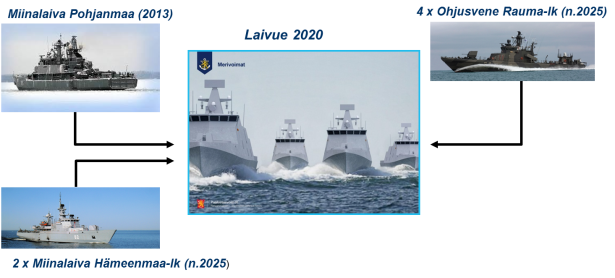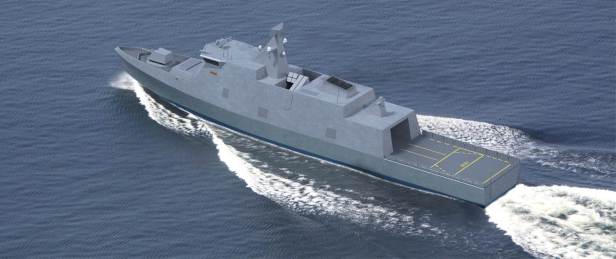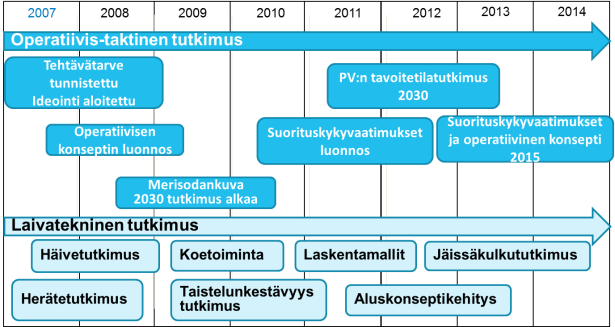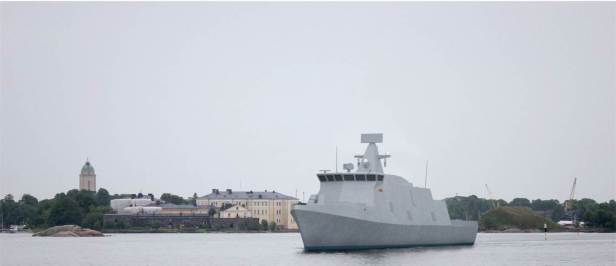Back to normal postings, after Friday’s special one.
The Minister of Defence yesterday officially gave the Finnish Defence Forces the go-ahead to start the procurement program of the next squadron of ships for the Finnish Navy. This program, going under the name of Laivue 2020 (fi. Squadron 2020), has as its stated aim the procurement of four (at the moment) corvettes to replace the three minelayers of the Pohjanmaa- and Hämeenmaa-classes, as well as the four light fast attack craft of the Rauma-class.

In general, most of what was said at the press conference held by the Minister of Defence Niinistö and the Commander of the Navy, Rear Admiral Takanen, is known from before. There will be a new class of ships, which will be built with a “high degree of indigenous content”, and which will be capable of performing “all missions the Navy by law is set to handle” (i.e. safeguarding Finnish merchant shipping and protecting our seaside borders from unwanted attention) all year round in all weather conditions. As such, these will feature both anti-air, anti-submarine, as well as anti-shipping capability. While geared towards ‘traditional’ coastal defence missions, they will also feature a secondary capability for international missions. Their most important distinguishing feature will be their size, which will make them some of the largest, if not the largest, warships throughout the history of the Finnish Navy.
Amongst the new information was that the timeline is getting clearer: the Requests for Information will be sent out this year or during the beginning of next, after which the Requests for Quotation will follow in late 2016/early 2017. The order should be finalised in 2018, after which the vessels will be built during 2019 to 2024, with initial operational capability 2025, and the squadron operational as a cohesive unit in 2028.

The rather crude concept renders, indicating either an early design stage or unwillingness to disclose details of the design, were not too telling either. The concept shown features a landing pad with a hangar (!). The hangar seems too small for housing the NH90 TTH used by the Finnish Army, and as the NH90 in any case would provide very limited value for maritime missions, this seems to indicate a readiness to procure a dedicated light maritime helicopter (e.g. the AW159 Wildcat) or unmanned helicopter system (e.g. the MQ-8 Fire Scout) at some point in the future. The weapons consists of a single turret mounted medium-calibre gun, twin quadruple launchers for anti-ship missiles, and a battery of VLS-launchers for air-to-surface missiles. A gun-based CIWS-system is not mounted, but may be an option. In the rear, the transom seems to hold a small hatch for deploying a towed array sonar. Still, as this is one of several designs, too much shouldn’t be read into these pictures (some have noted the similarity of the renders to the US Freedom-class LCS, or the Russian Steregushchy-class corvettes, however, that’s just the way most modern warships look these days, and the comparison could as easily be made to the German MEKO-designs, the Chinese Type 056, or the larger British Type 26 frigate).

The cost for the project is expected to be around 1.2 billion Euros for a unit cost (including R&D) of 300 million Euros. This will be handled outside of the normal defence budget, and while it is smaller than the potentially 10 billion Euro HX fighter-program, it is still a lot of money for a country with a bleak-ish looking economy and several other major programs coming up in the near future for the defence forces. This means that the procurement will meet resistance from certain political circles.
And this is the main gripe I have with the announcement. From the outline it is clear that much thought has gone into the decision to procure four warships of this size and according to the specification outlined. Still, what the general public and journalists are left with is a double-sided A4 and eight (!) PowerPoint slides. The main arguments presented are:
- Old ships must be retired
- The Navy needs new ones, otherwise it won’t be able to fulfil its duties written in the law

One does not need to be an oracle to foresee the debate that will follow the decision to acquire these (for Finland) large vessels. Do we really need them? Why can’t we make do with more FAC’s (as we have done for the last decades)? Can’t we just order more Hamina-class vessels? What shall we do to counter the loss of three hulls? Why do the Navy get these funds, when the Army anyway will be the one winning or losing any future wars? And so on…
The air force realised this, and the preliminary report made for the HX-program dealt with the similar questions that program will have to face to reach broad acceptance in today’s Finland. On 60+ pages, they explained in detail the background to the need for new fighters, why the capability can’t be solved by another mid-life update, or why can’t we just buy “cheap” UAV’s? They explained why we need at least as many fighters as we have today, and how the new aircraft will have to be fit for several different missions. And most important of all, they did all this in such a way that the reader with a casual interest in these questions understood their arguments, and they were provided nicely packaged for easy access.
The navy did none of this. While I don’t doubt that the navy has made their homework, and while I understand the need for secrecy, I do believe that the navy has taken things a step too far. In today’s society, it is not enough to ‘sell’ a project of this size to the decision makers; you need to sell it to the general public as well. So far, the navy seems reluctant to do this.



Comments are closed.